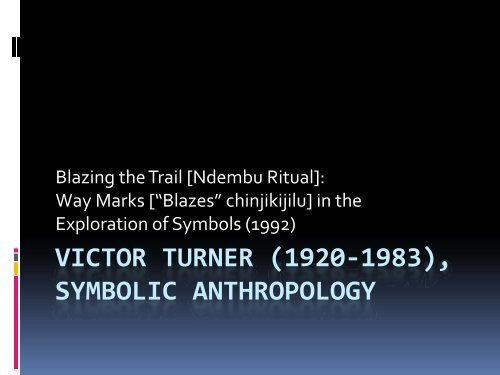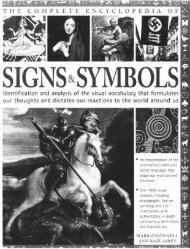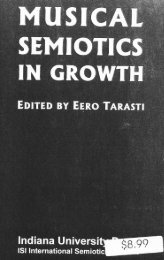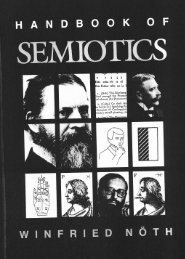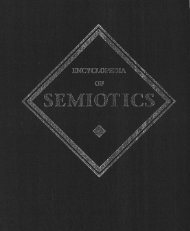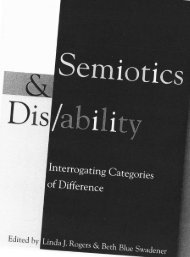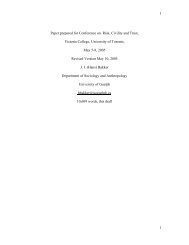Victor Turner, Symbolic Anthropology - SemioticSigns.com
Victor Turner, Symbolic Anthropology - SemioticSigns.com
Victor Turner, Symbolic Anthropology - SemioticSigns.com
You also want an ePaper? Increase the reach of your titles
YUMPU automatically turns print PDFs into web optimized ePapers that Google loves.
Blazing the Trail [Ndembu Ritual]:<br />
Way Marks [“Blazes” chinjikijilu] in the<br />
Exploration of Symbols (1992)<br />
VICTOR TURNER (1920‐1983),<br />
SYMBOLIC ANTHROPOLOGY
Max Gluckman (1911‐1975)<br />
• Research on tribes of<br />
Central and South<br />
America (1936‐1947)<br />
• Manchester U.<br />
• Openly anti‐colonial<br />
• Against racism<br />
• Politics, Law & Ritual<br />
• Judicial Processes<br />
among the Barotse of<br />
Northern Rhodesia
Claude Levi‐Strauss’<br />
Structuralism
Arnold van Gennep
Rites de passage
<strong>Victor</strong> <strong>Turner</strong>:<br />
Liminal States
Ndembu ritual symbols<br />
• A chinjikijilu is a land mark or blaze<br />
• Derived from kujikijila, to blaze a trail by<br />
cutting marks on trees<br />
• A blaze connects the known with the<br />
unknown territory; it marks the way<br />
• It also allows the hunter to re‐connect back to<br />
his village from the unexplored and unknown<br />
bush<br />
• Myth of the labyrinth (“string” for Theseus)
From Structuralist to Mystic to<br />
Symbologist to Liminality<br />
Theorist to Political<br />
Anthropologist!<br />
• <strong>Victor</strong> <strong>Turner</strong>’s intellectual quest led him from a<br />
Structuralist viewpoint through a series of major<br />
ideas<br />
• The idea of “the liminoid” (the in‐between, the<br />
no‐man’s land) is one he is often associated with<br />
(a “liminality theorist”)<br />
• His early Structuralism is both in terms of<br />
Durkheimian social facts and Freudian<br />
psychological facts
The Liminoid Phenomenon<br />
• <strong>Turner</strong> studied the liminal state in rites of<br />
passage in his earlier work<br />
• He borrowed the key idea from Arnold van<br />
Gennep, a Belgian anthropologist<br />
• But he extended the concept to cover the basic<br />
condition of modern, industrial capitalist<br />
societies and “post‐industrial,” information age<br />
societies<br />
• Religious rituals “embody” and give visible form<br />
to liminoid aspects of our subjective lives<br />
• He did not immediately associate with semiotics
Comparative Symbology<br />
or Semiotics?<br />
• <strong>Victor</strong> <strong>Turner</strong> used ideas as “idea units” and did<br />
not attempt to incorporate his theoretical<br />
formulations into broader paradigms or theory<br />
systems<br />
• His <strong>com</strong>parative work on symbols is largely<br />
Cartesian in that he thinks in terms of a dialectic<br />
of structure and anti‐structure<br />
• Objects in a museum are seen as giving visible<br />
form to cultural phenomena like ritual
Carl Gustav Jung’s<br />
Archetypes: Universal Symbols
Avalokiteshvara:<br />
bodhisattva of <strong>com</strong>passion
But are these Symbols in a<br />
Cartesian or a Peircian Sense?
Kinship and Structure:<br />
Generations & Ritual
Ndembu Funeral Rituals &<br />
Japanese Funeral Rituals
Field Work in Northern<br />
Rhodesia<br />
= Zambia; but, he extends<br />
• Ritual symbols<br />
• Interpretation of exegetical meaning<br />
the ideas to modern societies<br />
• Indigenous informants<br />
• Operational meaning<br />
• Gestalt of meanings (whole, “totality”)<br />
• Comparative symbology<br />
• “Communitas” (tt) = rudimentary structures in a<br />
society during a liminal period, leisure genres like<br />
entertainment in mass societies
“Social Dramas” (tt)<br />
• Not the same as Erving Goffman’s<br />
“dramaturgical sociology” (SI Pr)<br />
• Schism and conflict is played out in minisocial<br />
dramas and major social dramas<br />
• Dis‐harmony, aharmonic processes<br />
• Similar to sociological Conflict Theory<br />
• Conflict resolution occurs when “redressive<br />
action” stops the further spread of conflict<br />
(e.g. mediation, ritual)
Is <strong>Turner</strong>’s Approach<br />
Semiotic?<br />
• <strong>Turner</strong>’s symbolic anthropology is not<br />
necessarily <strong>com</strong>patible with Peirce’s semiotic<br />
approach<br />
• It is interesting to consider this because it seems<br />
to be so similar. After all, he deals with symbols<br />
and culture.<br />
• The main difference is a Cartesian approach to<br />
the subject (anthropologist) versus a Peircian<br />
approach that involves Interpretive Networks<br />
and Operationalized Representations.


